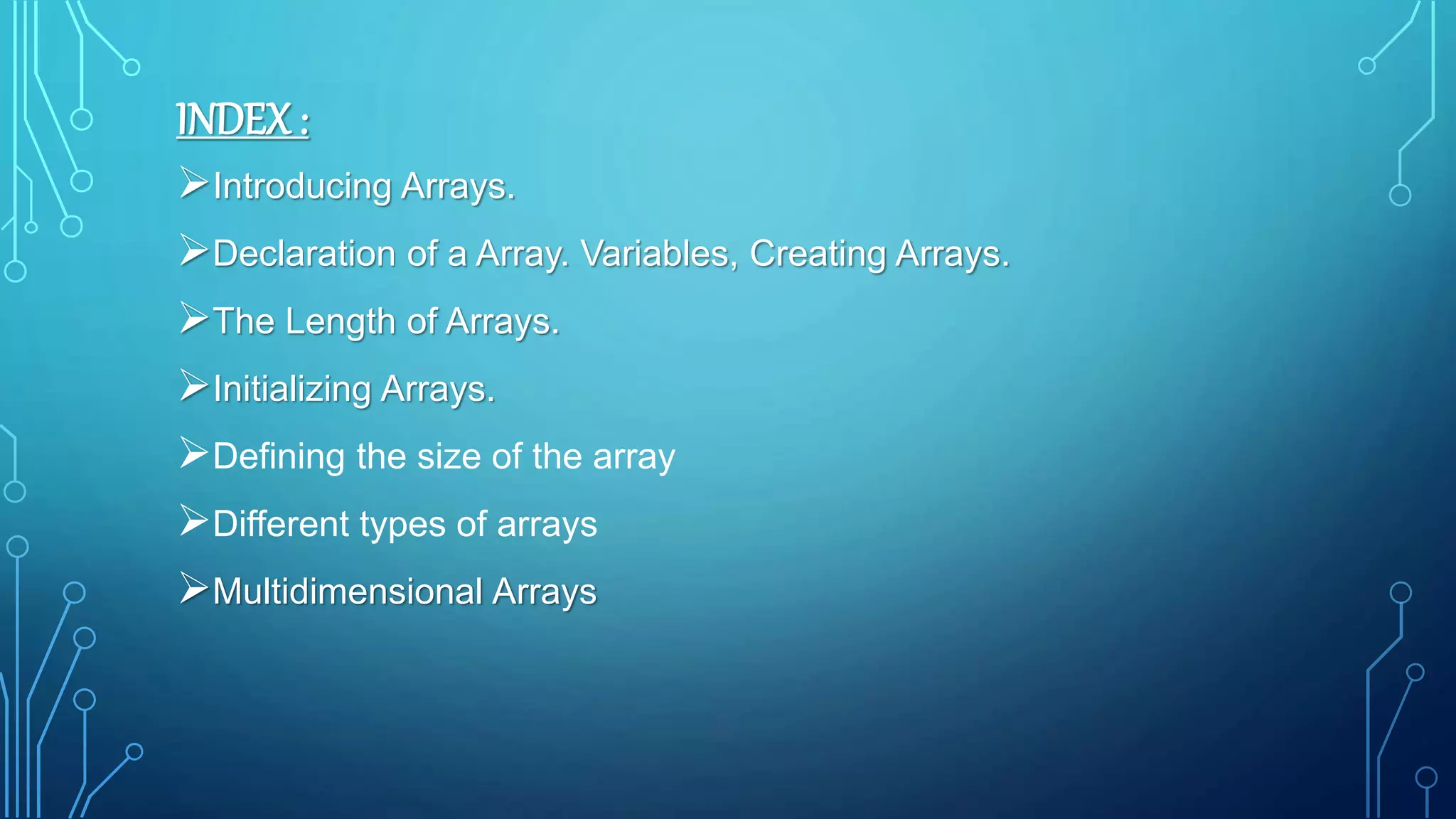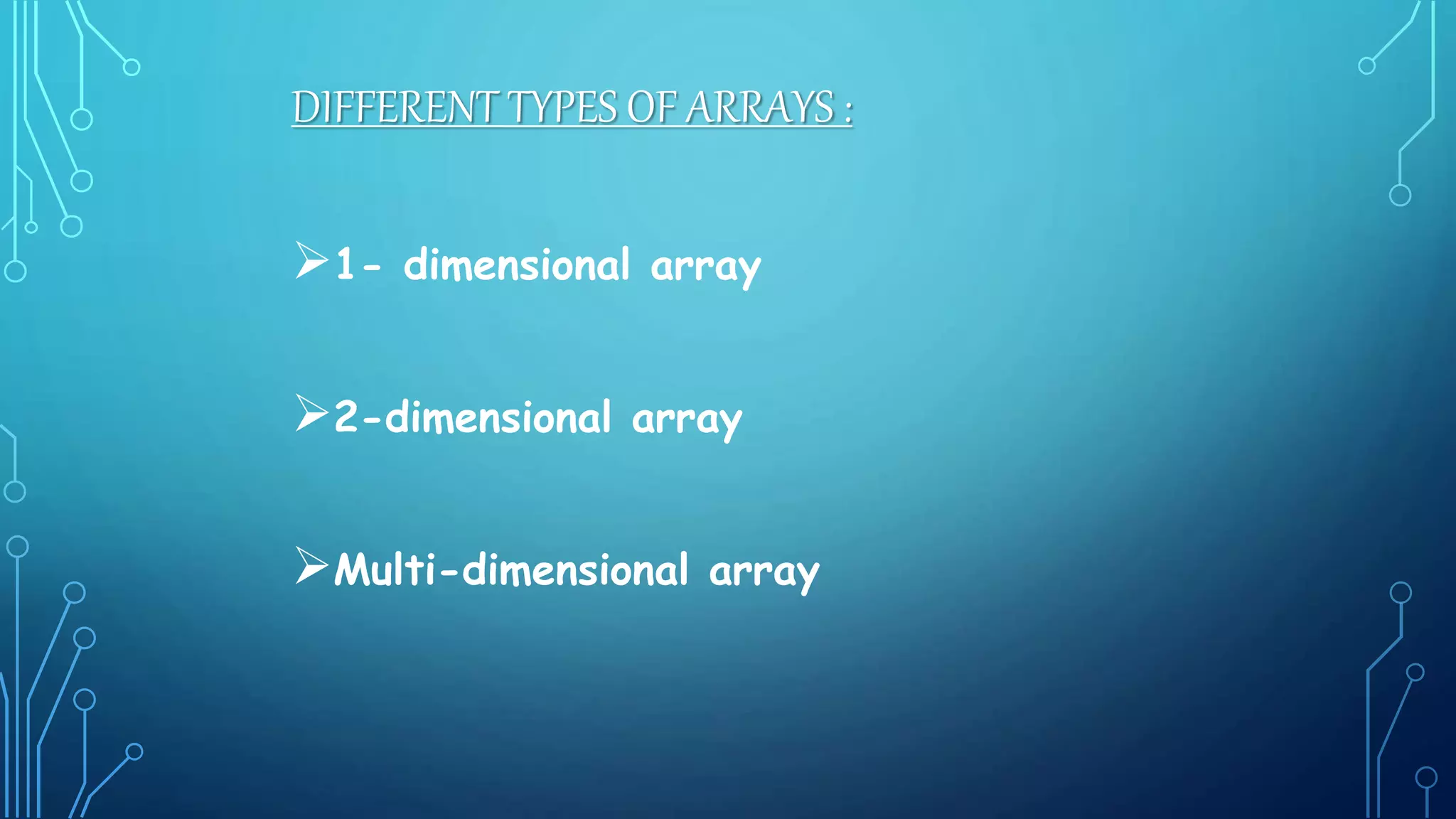The document presents a comprehensive overview of arrays in C programming, explaining their definition, declaration, initialization, and types including one-dimensional and multidimensional arrays. Key concepts include fixed size limitations of arrays and examples of both single and multi-dimensional array declarations and initializations. Additionally, it includes sample code for practical implementation of these concepts.



![INTRODUCING ARRAYS : An array is a collection of variables of the same type that are referred to through a common name. int num[10]; Num reference num [0] num[1] num[2] num [3] num[4] num[5] num[6] num[7] num[8] num[9]](https://image.slidesharecdn.com/basicarrayincprogramming-170410181719/75/Basic-array-in-c-programming-4-2048.jpg)
![DECLARING ARRAY VARIABLES : Data type array name[index]; Example: int list[10]; char num[15]; float hat[20];](https://image.slidesharecdn.com/basicarrayincprogramming-170410181719/75/Basic-array-in-c-programming-5-2048.jpg)
![CREATING ARRAYS : Data type array-name[size]; Example: int num[10]; num[0]references the first element in the array. num[9]references the last element in the array.](https://image.slidesharecdn.com/basicarrayincprogramming-170410181719/75/Basic-array-in-c-programming-6-2048.jpg)
![THE LENGTH OF ARRAYS : Once an array is created, its size is fixed. It cannot be changed. For Example, int arr[10]; You can not insert any number to arr[11] location because it is not initialized.](https://image.slidesharecdn.com/basicarrayincprogramming-170410181719/75/Basic-array-in-c-programming-7-2048.jpg)
![INITIALIZING ARRAYS : Declaring, creating, initializing in one step: int my Array[5] = {1, 2, 3, 4, 5}; int studentAge[4]; studentAge[0] = 14; studentAge[1] = 13; studentAge[2] = 15; studentAge[3] = 16;](https://image.slidesharecdn.com/basicarrayincprogramming-170410181719/75/Basic-array-in-c-programming-8-2048.jpg)
![DEFINING THE SIZE OF THE ARRAY : • It is a good programming practice to define the size of an array as symbolic constant • Example #define size 10 int a[size];](https://image.slidesharecdn.com/basicarrayincprogramming-170410181719/75/Basic-array-in-c-programming-9-2048.jpg)

![ONE-DIMENSIONAL ARRAYS : • One dimensional array have only one subscript under a common name. • syntax • Data_type array_name[array_size]; • Example • int age[5]={2,4,34,3,4};](https://image.slidesharecdn.com/basicarrayincprogramming-170410181719/75/Basic-array-in-c-programming-11-2048.jpg)
![EXAMPLE PROGRAM : #include<stdio.h> int main() { int a[4]; int i; for ( i = 0; i < 4; i++ ) { Scanf(“%d”,&a[i]); } for ( i = 0; i < 4; i++ ) printf("a[%d] = %dn", i , a[i]); return 0; }](https://image.slidesharecdn.com/basicarrayincprogramming-170410181719/75/Basic-array-in-c-programming-12-2048.jpg)
![TWO-DIMENSIONAL ARRAYS : Two-dimensional array are those type of array, which has finite number of rows and finite number of columns. 2D arrays are generally known as matrix. We will discuss two Dimensional array in detail but before this have a look at the below piece of code . Data_type Array_name [row size][column size];](https://image.slidesharecdn.com/basicarrayincprogramming-170410181719/75/Basic-array-in-c-programming-13-2048.jpg)
![Rows Columns int color[r] [c]; [0] [1] [2] [0] [1] [2]](https://image.slidesharecdn.com/basicarrayincprogramming-170410181719/75/Basic-array-in-c-programming-14-2048.jpg)
![EXAMPLE PROGRAM : #include<stdio.h> int main() { int disp[3][5]; int i, j; for(i=0; i<=2; i++) { for(j=0;j<=4;j++) { printf("Enter value for disp[%d][%d]:", i, j); scanf("%d", &disp[i][j]); } } return 0; }](https://image.slidesharecdn.com/basicarrayincprogramming-170410181719/75/Basic-array-in-c-programming-15-2048.jpg)
![MULTI-DIMENSIONAL ARRAYS : An array have multiple subscript under a common name. Syntax type name[size1][size2]...[sizeN]; Example float a[2][6][7][4]….[n];](https://image.slidesharecdn.com/basicarrayincprogramming-170410181719/75/Basic-array-in-c-programming-16-2048.jpg)
![EXAMPLE PROGRAM : int matrix[10] [10]; for (i=0; i<10; i++) for (j=0; j<10; j++) { matrix[i] [j] = i * j; } float mat[5] [5];](https://image.slidesharecdn.com/basicarrayincprogramming-170410181719/75/Basic-array-in-c-programming-17-2048.jpg)
![INITIALIZING OF MULTIDIMENSIONAL ARRAYS : This is equivalent to the following statements: array[0][0] = 1; array[0][1] = 2; array[0][2] = 3; array[1][0] = 4; array[1][1] = 5; array[1][2] = 6; array[2][0] = 7; array[2][1] = 8; array[2][2] = 9; array[3][0] = 10; array[3][1] = 11; array[3][2] = 12;](https://image.slidesharecdn.com/basicarrayincprogramming-170410181719/75/Basic-array-in-c-programming-18-2048.jpg)
